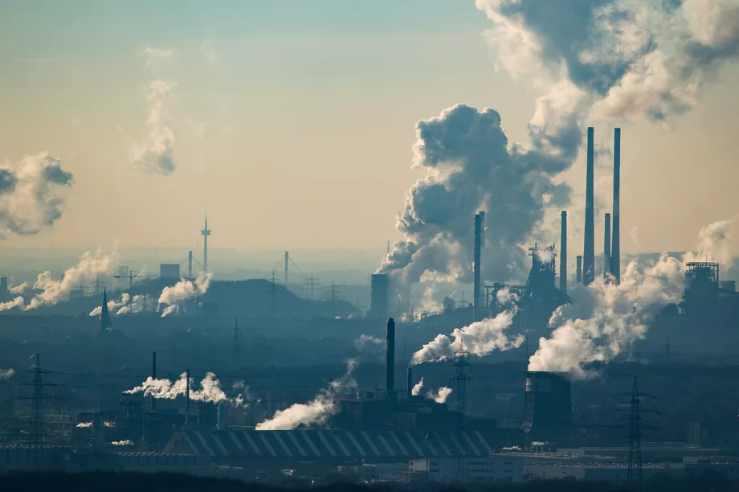 Steam and exhaust rise from a chemical factory and coking plant in Germany. Photo by Lukas Schulze/Getty Images
Steam and exhaust rise from a chemical factory and coking plant in Germany. Photo by Lukas Schulze/Getty Images
The suggested use-cases are varied, ranging from using AI and satellite imagery to better monitor deforestation, to developing new materials that can replace steel and cement (the production of which accounts for nine percent of global green house gas emissions).
AI IS NO SILVER BULLET, BUT IT WILL PROVE INVALUABLE IN THE COMING CLIMATE FIGHTBut despite this variety, the paper (which we spotted via MIT Technology Review) returns time and time again to a few broad areas of deployment. Prominent among these are using machine vision to monitor the environment; using data analysis to find inefficiencies in emission-heavy industries; and using AI to model complex systems, like Earth’s own climate, so we can better prepare for future changes.
The authors of the paper — which include DeepMind CEO Demis Hassabis, Turing award winner Yoshua Bengio, and Google Brain co-founder Andrew Ng — say that AI could be “invaluable” in mitigating and preventing the worse effects of climate change, but note that it is not a “silver bullet” and that political action is desperately needed, too.
“Technology alone is not enough,” write the paper’s authors, who were led by David Rolnick, a postdoctoral fellow at the University of Pennsylvania. “[T]echnologies that would reduce climate change have been available for years, but have largely not been adopted at scale by society. While we hope that ML will be useful in reducing the costs associated with climate action, humanity also must decide to act.”
In total, the paper suggests 13 fields where machine learning could be deployed (from which we’ve selected eight examples), which are categorized by the time-frame of their potential impact, and whether or not the technology involved is developed enough to reap certain rewards. You can read the full paper for yourself here, or browse our list below.
Build better electricity systems. Electricity systems are “awash with data” but too little is being done to take advantage of this information. Machine learning could help by forecasting electricity generation and demand, allowing suppliers to better integrate renewable resources into national grids and reduce waste. Google’s UK lab DeepMind has demonstrated this sort of work already, using AI to predict the energy output of wind farms.
Monitor agricultural emissions and deforestation. Greenhouse gases aren’t just emitted by engines and power plants — a great deal comes from the destruction of trees, peatland, and other plant life which has captured carbon through the process of photosynthesis over millions of years. Deforestation and unsustainable agriculture leads to this carbon being released back into the atmosphere, but using satellite imagery and AI, we can pinpoint where this is happening and protect these natural carbon sinks.
Create new low-carbon materials. The paper’s authors note that nine percent of all global emissions of greenhouse gases come from the production of concrete and steel. Machine learning could help reduce this figure by helping to develop low-carbon alternatives to these materials. AI helps scientists discover new materials by allowing them to model the properties and interactions of never-before-seen chemical compounds.
Predict extreme weather events. Many of the biggest effects of climate change in the coming decades will be driven by hugely complex systems, like changes in cloud cover and ice sheet dynamics. These are exactly the sort of problems AI is great at digging into. Modeling these changes will help scientists predict extreme weather events, like droughts and hurricanes, which in turn will help governments protect against their worst effects.
Make transportation more efficient. The transportation sector accounts for a quarter of global energy-related CO2 emissions, with two-thirds of this generated by road users. As with electricity systems, machine learning could make this sector more efficient, reducing the number of wasted journeys, increasing vehicle efficiency, and shifting freight to low-carbon options like rail. AI could also reduce car usage through the deployment of shared, autonomous vehicles, but the authors note that this technology is still not proven.
Reduce wasted energy from buildings. Energy consumed in buildings accounts for another quarter of global energy-related CO2 emissions, and presents some of “the lowest-hanging fruit” for climate action. Buildings are long-lasting and are rarely retrofitted with new technology. Adding just a few smart sensors to monitor air temperature, water temperature, and energy use, can reduce energy usage by 20 percent in a single building, and large-scale projects monitoring whole cities could have an even greater impact.
Geoengineer a more reflective Earth. This use-case is probably the most extreme and speculative of all those mentioned, but it’s one some scientists are hopeful about. If we can find ways to make clouds more reflective or create artificial clouds using aerosols, we could reflect more of the Sun’s heat back into space. That’s a big if though, and modeling the potential side-effects of any schemes is hugely important. AI could help with this, but the paper’s authors note there would still be significant “governance challenges” ahead.
Give individuals tools to reduce their carbon footprint. According to the paper’s authors, it’s a “common misconception that individuals cannot take meaningful action on climate change.” But people do need to know how they can help. Machine learning could help by calculating an individual’s carbon footprint and flagging small changes they could make to reduce it — like using public transport more; buying meat less often; or reducing electricity use in their house. Adding up individual actions can create a big cumulative effect.